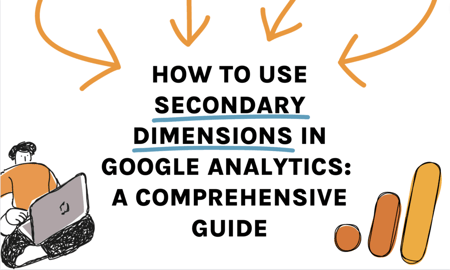Enhance Your Data Analysis Making Use Of Additional Measurements
The real depth of understandings lies in the combination of second dimensions. The critical usage of second dimensions elevates analysis past the surface area level, assuring a riches of untapped prospective waiting to be discovered.
Comprehending Additional Dimensions
Second dimensions in information evaluation refer to additional characteristics or metrics that provide deeper insights when incorporated with main data measurements, boosting the total understanding of the dataset. These extra measurements provide an even more thorough sight of the information, enabling experts to reveal surprise patterns, relationships, and patterns that might not be obvious when just thinking about primary dimensions.
By incorporating secondary dimensions right into data evaluation, experts can obtain a more nuanced understanding of the variables affecting the main metrics. In advertising and marketing evaluation, main dimensions can consist of standard client demographics like age and gender, while additional dimensions might encompass variables such as acquiring behavior, preferences, or geographic place. By incorporating these additional and primary measurements, experts can produce extra comprehensive client accounts, making it possible for even more targeted and efficient advertising methods.
Moreover, secondary dimensions can aid in recognizing relationships between various variables, leading to more exact anticipating modeling and decision-making. They make it possible for analysts to explore data from several point of views, improving the insights drawn from the dataset and ultimately improving the top quality of evaluation and tactical suggestions.
Advantages of Secondary Dimensions
When taking into consideration data evaluation, including secondary measurements supplies a wide variety of advantages that substantially improve the deepness and breadth of understandings derived from main information measurements. One of the essential benefits of secondary measurements is the capability to supply context to key data. By adding additional dimensions such as time, place, or demographic information to the analysis, scientists can gain a much more comprehensive understanding of the main data factors - secondary dimensions. This contextual details can aid determine patterns, trends, and correlations that might have or else gone unnoticed.
In addition, secondary measurements can also aid in segmenting data, enabling for an extra comprehensive analysis of details parts within the main data. This division can lead to even more targeted techniques and actions based upon the unique characteristics of each segment. Additionally, additional dimensions can help in confirming searchings for from primary data dimensions, providing a more robust and dependable basis for decision-making.
Basically, the benefits of integrating second dimensions into data analysis are indispensable, providing richer insights and enabling more educated decision-making processes.
Implementing Second Dimensions Efficiently
Efficient execution of second dimensions in information evaluation requires a tactical method that makes the most of the utility of extra contextual details. When including secondary measurements, it is crucial to align them with the main dimensions to gain deeper understandings right into the information. Beginning by clearly specifying the objectives of the evaluation to figure out which secondary measurements will certainly give one of the most pertinent context. It is vital to choose secondary dimensions that enhance the primary data without causing noise or confusion in the evaluation.
Additionally, take into consideration the scalability of the second measurements check these guys out across various datasets or analyses. By implementing second measurements efficiently, analysts can boost the deepness and accuracy of their information analysis, leading to more enlightened decision-making and actionable insights.
Advanced Techniques With Second Measurements
For a much more advanced approach to information analysis, including additional dimensions can considerably boost the depth of insights gotten. Advanced techniques with second dimensions include more detailed techniques to remove important information from data collections. One such method is accomplice evaluation, where data is fractional based on certain characteristics or actions to track patterns in time. This approach allows for a much deeper understanding of how various teams progress and connect with your services or product.
An additional advanced method is regression evaluation, which aids recognize relationships between variables and exactly how they influence each various other. By including additional measurements, such as group details or user habits, to regression designs, you can discover extra nuanced understandings and make even more accurate predictions.

Case Researches: Additional Measurements at work

In one more circumstance, a doctor leveraged additional dimensions to maximize resource allocation. By assessing client outcomes in relationship to geographical location, the company determined locations with high readmission rates. This brought about the application of targeted intervention programs in those areas, eventually boosting client treatment and decreasing medical care expenses.
These instance research studies highlight the power of secondary measurements in uncovering useful understandings that drive tactical decision-making. By diving deeper into information evaluation beyond key metrics, organizations can get an extra extensive understanding of their clients and procedures, leading to more enlightened and effective business approaches.
Conclusion
Finally, the consolidation of second dimensions in data analysis is crucial for gaining a detailed understanding of underlying why not find out more trends and aspects. By making use of strategies such as cohort analysis and regression analysis, organizations can uncover hidden insights and make more educated choices. Second measurements include deepness and breadth to information evaluation, allowing businesses to explore data from multiple point of views and drive a lot more efficient end results.
In advertising analysis, key measurements could consist of basic consumer demographics like age and sex, while secondary measurements could incorporate variables such navigate here as buying habits, choices, or geographic area.When thinking about data evaluation, incorporating second dimensions supplies a wide range of benefits that considerably boost the depth and breadth of understandings derived from key data measurements.Additionally, second dimensions can additionally help in segmenting data, permitting for a more thorough analysis of certain parts within the primary information. Additionally, additional measurements can aid in validating searchings for from primary data measurements, providing a much more durable and dependable basis for decision-making.
When integrating second measurements, it is essential to straighten them with the key dimensions to acquire deeper understandings right into the data.